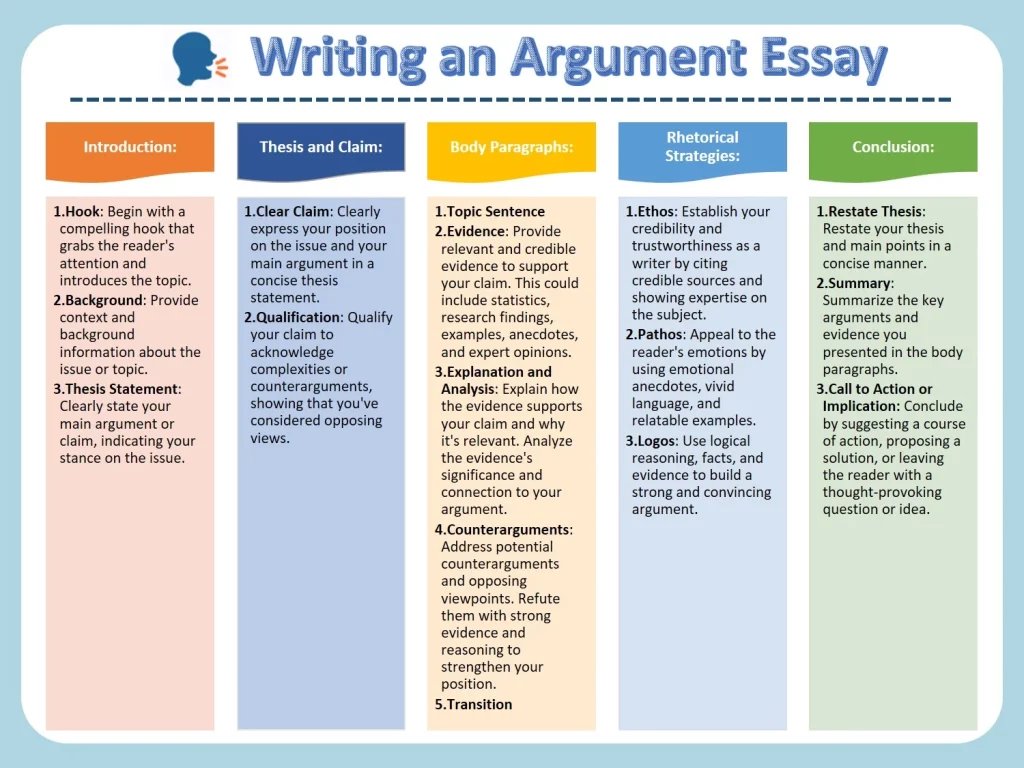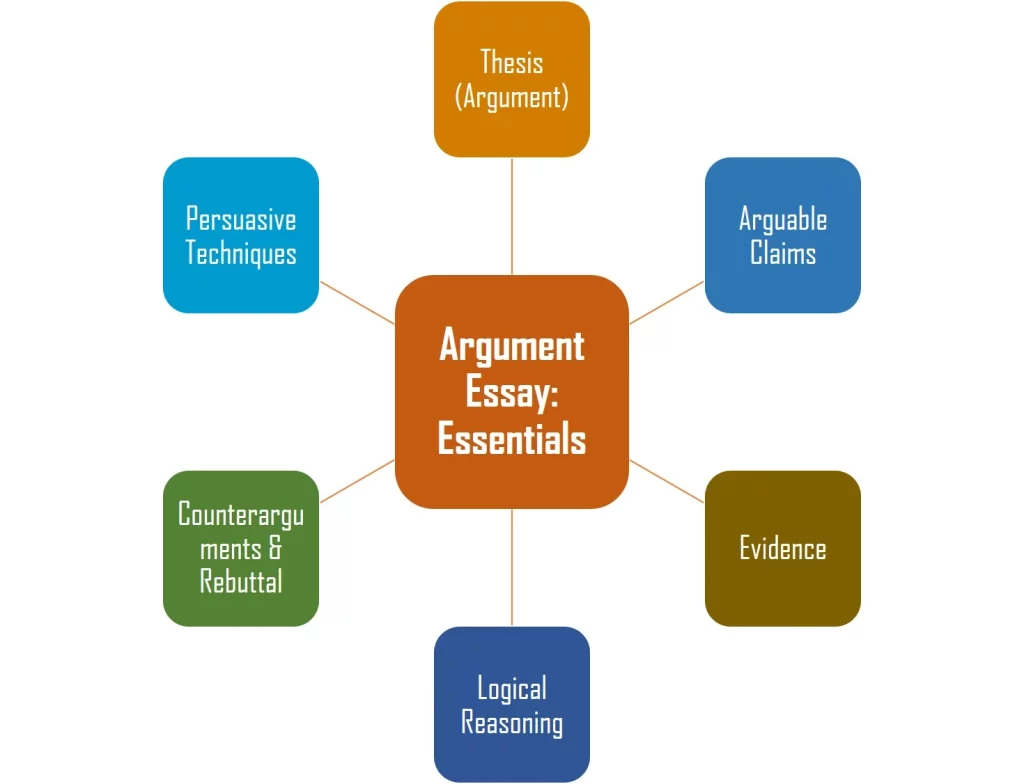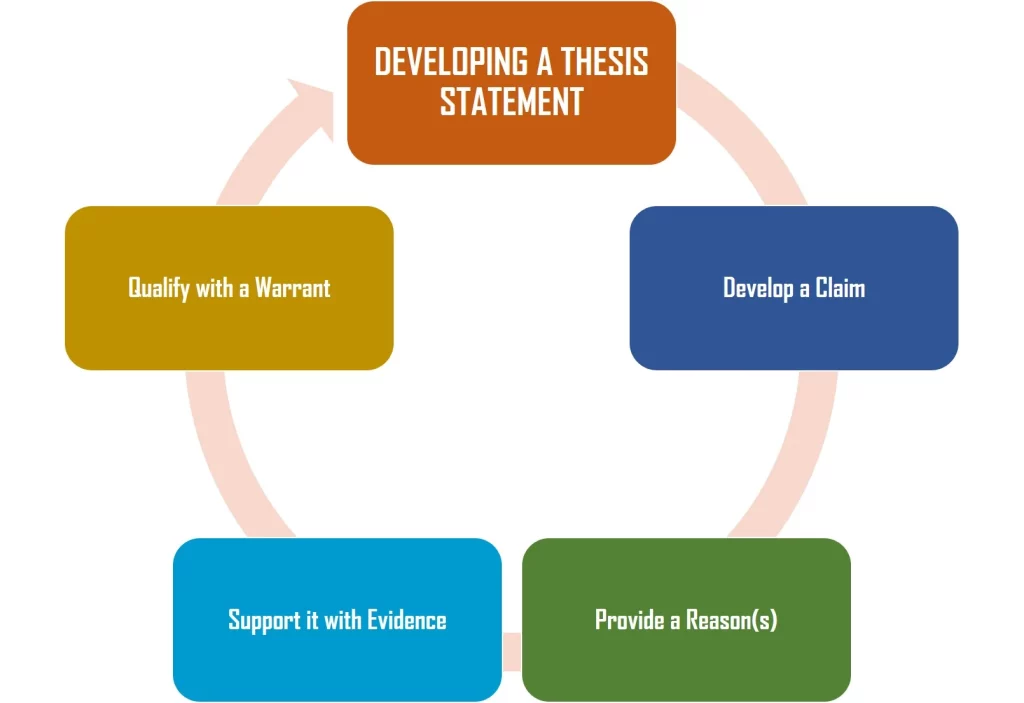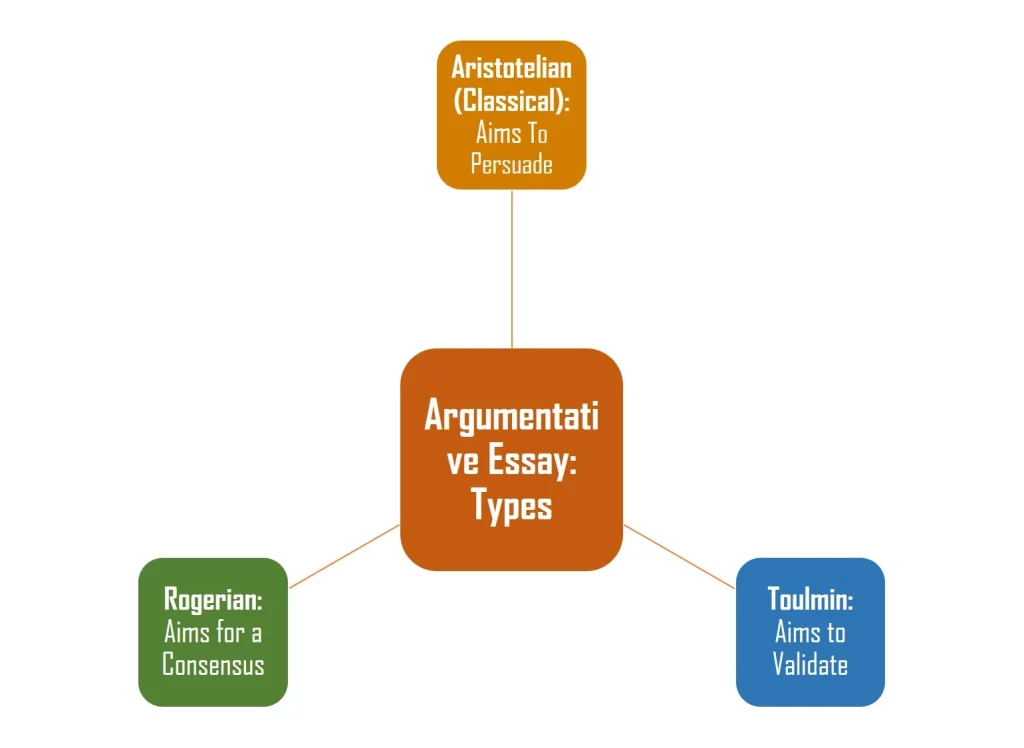- 5-Paragraph Argumentative Essay on Euthanasia
- Aristotelian Argument Essay on Marijuana
- Toulmin Argument Essay on Artificial Intelligence
- Rogerian Argument Essay on Gun Control
- Rebuttal Argument Essay on Renewable Energy
- Sample Historical Argument Essay on the Industrial Revolution
- Literary Argument Essay on 'The Cask of Amontillado'
- Persuasive Argument Essay: Financial Literacy
- Persuasive Argument Essay: Social Media and Politics
- Proposal Argument Essay on Reusable Containers
- Proposal Argument Essay on Workplace Wellness
- Rhetorical Evaluation Argument Essay: MLK's "I Have a Dream"
- Literary Evaluative Argument Essay: "To Kill a Mockingbird"
- Narrative Argument Essay on Resilience
- Definition Argument Essay on Privacy
- Causal Argument Essay on Education
 An argumentative essay is a type of academic or persuasive writing in which the author presents a particular point of view or argument on a specific topic and provides evidence and reasoning to support that argument. The primary goal of an argumentative essay is to convince the reader to adopt the author’s perspective or take a particular course of action.
An argumentative essay is a type of academic or persuasive writing in which the author presents a particular point of view or argument on a specific topic and provides evidence and reasoning to support that argument. The primary goal of an argumentative essay is to convince the reader to adopt the author’s perspective or take a particular course of action.
Here is a sample 5-paragraph argumentative essay for students:
Sample 5-Paragraph Argument Essay on Legalizing Euthanasia
Key Elements

Here is a discussion of the key elements of an argumentative essay:
- Argument (Thesis Statement):
- Arguable Claims:
- Evidence:
- Logic & Reasoning:
- Counterarguments and Rebuttal:
- Persuasive Techniques:
In an effective argumentative essay, these elements work together to build a compelling and well-structured case for your thesis. The argument is supported by arguable claims, substantiated by evidence, presented with logical reasoning, and fortified against counterarguments. Persuasive techniques help you engage the reader and make your case more convincing. The goal is to persuade the audience to accept or at least seriously consider your point of view on the given topic.
General Outline
- Introduction:
- Body paragraphs (3 or more):
- Conclusion:
- Citations:
Remember to maintain a logical flow throughout your essay, with each paragraph building upon the previous one. Use transitional words and phrases to connect ideas and create coherence. Additionally, ensure that your essay is well-supported with credible evidence, properly cited, and free of any fallacies or logical errors.
How to Write: Steps
- Choose a Topic:
- Research:
- Develop a Thesis Statement:
- Outline Your Essay:
- Write the Introduction:
- Write the Body Paragraphs:
- Address Counterarguments:
- Write the Conclusion:
- Revise and Edit:
- Finalize Your Essay:
Remember to maintain a respectful and persuasive tone throughout your argumentative essay. You should aim to engage your audience and convince them of the validity of your argument. By following this step-by-step process, you can effectively write a well-structured and compelling argumentative essay.
Developing a Debatable Thesis Statement (Argument)

In essay writing, an argument refers to the central claim or thesis statement that you present and support throughout your essay. It is the main idea or position you are putting forward and trying to convince your readers to accept. The components of an argument include the claim, reason, support, and warrant. Let’s take a closer look at each of these components:
- Claim: The claim is the central proposition or main idea of your argument. It is the statement you are putting forward and seeking to convince your readers to accept. A strong claim is specific, debatable, and serves as the foundation for your argument.
- Reason: The reason is the logical explanation or rationale behind your claim. It provides the “why” or justification for your position. A reason should be logical, relevant, and support the claim you are making.
- Support: Support refers to the evidence or examples you present to substantiate your reason and strengthen your claim. It can include facts, statistics, expert opinions, research findings, anecdotes, or logical arguments. The support should be credible, reliable, and directly related to the reason and claim you are making.
- Warrant: The warrant connects the support to the claim and explains the logical connection between them. It serves as the bridge that demonstrates how the evidence or reasoning supports the claim. The warrant provides the underlying assumptions, principles, or generalizations that link the support to the claim. It helps to establish the validity and relevance of the evidence.
Here is an example of a strong thesis statement for an argumentative essay about the benefits of regular exercise:
“Engaging in regular exercise offers numerous benefits, including improved physical health through cardiovascular fitness and muscular strength, as well as enhanced mental well-being through the release of endorphins, ultimately contributing to an overall healthier lifestyle.”
Here is a breakdown of this example:
- Claim: Regular exercise leads to improved physical and mental health.
- Reason: Engaging in regular exercise promotes cardiovascular fitness, strengthens muscles, and releases endorphins, which contribute to overall well-being.
- Support:
- Warrant: The evidence provided supports the claim by demonstrating the direct and indirect positive effects of exercise on both physical and mental health. The cardiovascular benefits and the release of endorphins provide a physiological basis for improved well-being. Moreover, personal testimonials contribute anecdotal evidence, reinforcing the claim by showcasing real-life experiences of individuals who have reaped the benefits of regular exercise.
These components work together to construct a well-structured and persuasive argument. The claim presents the main idea, the reason explains the rationale, the support provides evidence, and the warrant connects everything, ensuring the coherence and strength of the argument.
By carefully crafting each component, you can build a compelling case that convinces your readers of the validity of your position.
How to Incorporate Evidence, Logical Reasoning, and Persuasive Techniques
- Evidence:
- Logical Reasoning:
- Persuasive Techniques:
By incorporating these elements into your argumentative essay, you can create a strong and persuasive piece of writing that effectively communicates your position and convinces your audience. Remember, to make your argument well-rounded and compelling, it’s essential to strike a balance between evidence, logic, and persuasive techniques.
Types & Sample Essays

The three main types of argumentative essays—Classical (Aristotelian) Arguments, Toulmin Arguments, and Rogerian Arguments—differ in their approaches and structures:
Classical (Aristotelian) Arguments:
- Key Features:
- Purpose: To persuade through a balanced combination of logic, credibility, and emotional engagement.
- Example: An essay advocating for a change in school policy might start with logic (logos) by presenting data on the policy’s impact, appeal to the school’s reputation and ethics (ethos) by emphasizing the school’s values, and then appeal to parents’ concerns and emotions (pathos) to rally support.
Sample Classical Argument Essay on Marijuana
Toulmin Arguments:
- Key Features:
- Purpose: To create clear and structured arguments with a well-defined structure.
- Example: An essay arguing for stricter environmental regulations might state a claim (e.g., “Environmental regulations need to be strengthened”), present evidence (data on pollution levels and environmental damage), provide a warrant (explaining the connection between evidence and claim), and anticipate a counterargument by addressing potential objections.
Sample Toulmin Argument Essay on Artificial Intelligence
Rogerian Arguments:
- Key Features:
- Purpose: To resolve conflicts, find middle ground, and establish understanding between differing perspectives.
- Example: An essay on a controversial social issue, such as gun control, might first present the opposing view’s concerns and values, seek common ground (e.g., promoting safety), and then discuss possible solutions or compromises.
Sample Rogerian Argument Essay on Gun Control
Each type of argumentative essay has its strengths and is suitable for different contexts and audiences. The choice of which type to use depends on the argument’s purpose, the audience’s receptiveness, and the writer’s approach to persuasion and reasoning.
Techniques of Development Based on Purpose
- Definition Arguments:
- Causal Arguments:
- Evaluation Arguments:
- Narrative Arguments:
- Rebuttal Arguments:
- Proposal Arguments:
- Persuasive Arguments:
- Literary Arguments:
- Rhetorical Arguments:
- Legal Arguments:
- Historical Arguments:
Each of these argumentative techniques serves a unique purpose and may be applied in various contexts. The choice of which technique to use depends on the topic, the purpose of the argument, and the intended audience. Effective argumentative essays often incorporate multiple techniques to build a comprehensive and persuasive case.
Logical Reasoning
- Deductive Reasoning:
- Inductive Reasoning:
- Abductive Reasoning:
- Analogical Reasoning:
- Conditional Reasoning:
- Syllogistic Reasoning:
- Modal Logic:
- Quantificational Reasoning:
These different types of logical reasoning serve various purposes and are applicable in different contexts, including philosophy, science, mathematics, law, and everyday problem-solving. The choice of which type of reasoning to use depends on the nature of the argument and the information available.
Frequently Asked Questions (FAQs)
-
What is the difference between an argumentative essay and a persuasive essay?
An argumentative essay aims to present a balanced, well-reasoned argument and uses evidence to support a specific position. It acknowledges and addresses counterarguments. A persuasive essay, on the other hand, primarily focuses on convincing the reader to adopt the writer’s viewpoint. It relies heavily on persuasive appeals and may not always present evidence or counterarguments.
-
How do I choose a relevant and compelling topic for my argumentative essay?
-
What are the key components of a strong thesis statement in an argumentative essay?
-
How can I effectively address counterarguments in my essay?
-
What’s the process for researching and citing sources in an argumentative essay?
-
How do I organize my essay’s body paragraphs for maximum impact?
-
What persuasive techniques can I use to make my argument more compelling?
-
How can I revise and edit my argumentative essay to improve its quality?
-
What are some ethical considerations in argumentative writing, especially when discussing controversial topics?
Remember, the key to writing a successful argumentative essay is to construct a well-reasoned, persuasive, and well-structured argument supported by credible evidence while also acknowledging and addressing counterarguments.
Argumentative essays are commonly assigned in academic settings as they develop critical thinking, research, and persuasive writing skills. They are often used to discuss controversial topics, analyze social issues, or evaluate different/opposing sides of an argument. They require a careful and structured presentation of evidence and a logical progression of ideas to persuade the reader of the validity of the author’s argument.
